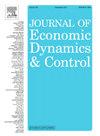Continuous-time persuasion by filtering
IF 2.3
3区 经济学
Q2 ECONOMICS
引用次数: 0
Abstract
We frame dynamic persuasion in a partial observation stochastic control Leader-Follower game with an ergodic criterion. The Receiver controls the dynamics of a multidimensional unobserved state process. Information is provided to the Receiver through a device designed by the Sender that generates the observation process. The commitment of the Sender is enforced. We develop this approach in the case where all dynamics are linear and the preferences of the Receiver are linear-quadratic. We prove a verification theorem for the existence and uniqueness of the solution of the HJB equation satisfied by the Receiver's value function. An extension to the case of persuasion of a mean field of interacting Receivers is also provided. We illustrate this approach in two applications: the provision of information to electricity consumers with a smart meter designed by an electricity producer; the information provided by carbon footprint accounting rules to companies engaged in a best-in-class emissions reduction effort. In the first application, we link the benefits of information provision to the mispricing of electricity production. In the latter, we show that even in the absence of information cost, it might be optimal for the regulator to blur information available to firms to prevent them from coordinating on a higher level of carbon footprint to reduce their cost of reaching a below average emission target.
通过过滤的连续时间说服
我们构造了具有遍历准则的部分观察随机控制Leader-Follower博弈的动态说服。接收者控制多维未观察状态过程的动态。信息通过发送方设计的产生观察过程的设备提供给接收方。发送方的承诺被强制执行。我们在所有动态都是线性的情况下开发这种方法,并且接收器的偏好是线性二次的。证明了由Receiver值函数满足的HJB方程解的存在唯一性定理。本文还对相互作用的接收者的平均场的说服情况进行了推广。我们在两个应用中说明了这种方法:通过电力生产商设计的智能电表向电力消费者提供信息;碳足迹会计准则向从事同类最佳减排工作的公司提供的信息。在第一个应用中,我们将信息提供的好处与电力生产的错误定价联系起来。在后者中,我们表明,即使在没有信息成本的情况下,监管者模糊企业可获得的信息,以防止它们在更高的碳足迹水平上进行协调,以降低达到低于平均排放目标的成本,这可能是最优的。
本文章由计算机程序翻译,如有差异,请以英文原文为准。
求助全文
约1分钟内获得全文
求助全文
来源期刊

Journal of Economic Dynamics & Control
ECONOMICS-
CiteScore
3.10
自引率
10.50%
发文量
199
期刊介绍:
The journal provides an outlet for publication of research concerning all theoretical and empirical aspects of economic dynamics and control as well as the development and use of computational methods in economics and finance. Contributions regarding computational methods may include, but are not restricted to, artificial intelligence, databases, decision support systems, genetic algorithms, modelling languages, neural networks, numerical algorithms for optimization, control and equilibria, parallel computing and qualitative reasoning.
 求助内容:
求助内容: 应助结果提醒方式:
应助结果提醒方式:


